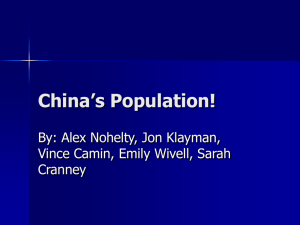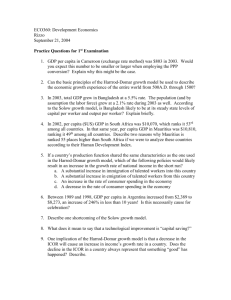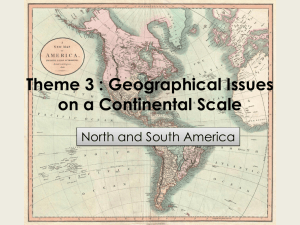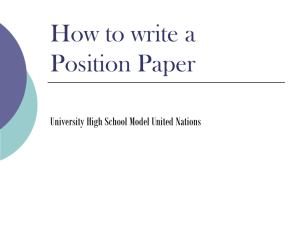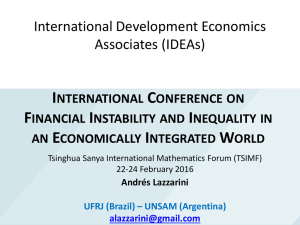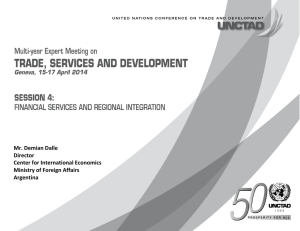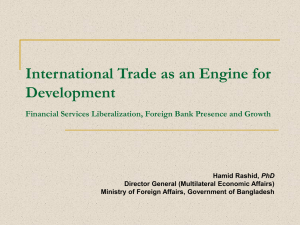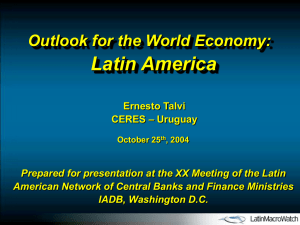Argentina*s Economic History and Recent Growth: A Decomposition
advertisement
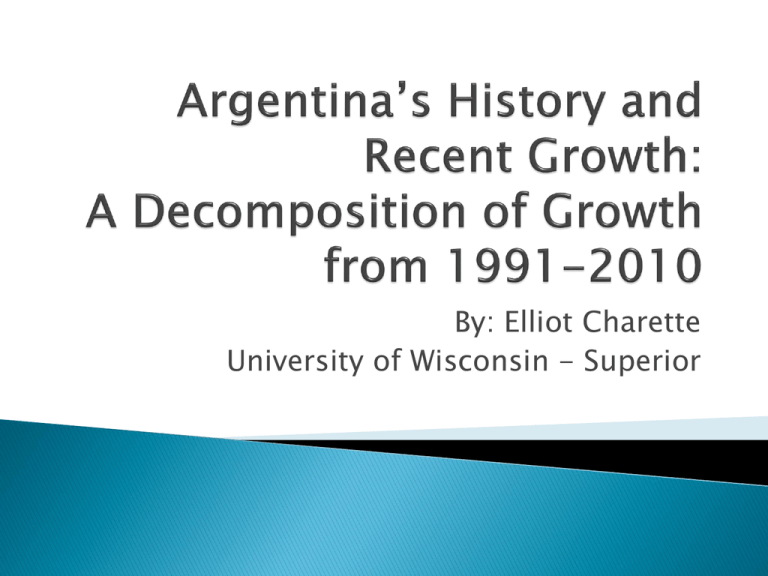
By: Elliot Charette University of Wisconsin - Superior Historical analysis ◦ Natural resources and political system Empirical analysis ◦ Empirical decomposition ◦ Cobb-Douglas framework Argentina ◦ 1900-1930 Austria, Germany, France, and Sweden ◦ Better than Italy and Spain (measured by GNI) ◦ Very productive agricultural sector Advanced country/economy during this time The Pampas! ◦ Fertile land ◦ Grain and pastures for cattle ◦ Allowed for high volume of agricultural exports 6% of property owners owned 70% of the Pampas End of the 1930s and early 1940s Unequal distribution of land ◦ Land owners didn’t invest in industrial capital Lack of industrial capital led to less competiveness in the global market Imported European goods From the 1930s to 1976 Perón extends tariff protections, exchange controls, and import licenses ◦ ‘Protects’ domestic industry from global competition ◦ 1945 industry contributes more than agriculture as a share of GDP Adoption of more neoliberal reforms ◦ Aimed at creating more competition More efficiency 1990s ◦ Extreme liberalization of economy Cuts social programs and government employees 1900-1930: Strong Agriculture, Wealthy Country 1931-1976: Protectionism, Declining Prosperity 1976 - 2010: Liberalization, ???? How much does each factor contribute to growth? ◦ Not much research on recent growth ◦ How much does total factor productivity contribute to GDP? Data 1991-2010 ◦ Source: Penn World Table and World Bank (Zhu 2012) Average Annual Growth Rates (%) Time Period GDP per capita Labor force Capital Average participation rate per worker human capital 1991-2010 4.19 0.15 3.28 1.58 Total Factor Productivity 1.31 Contributions to per capita GDP growth (%) Time Period 1991-2010 GDP per capita 100 Labor force Capital Average Total Factor participation rate per worker human capital Productivity 3.65 19.60 37.70 39.06 LFPR was a small factor contributing to GDP ◦ Possibly because of small, constant pop growth Capital contributed to 19% of growth Human capital was a large factor (37%!!!) ◦ High literacy rates ◦ “Right to education” Total factor productivity largest factor at 39% ◦ Possibly liberalization? More research needs to be done Brennan, J. (2007). Prolegomenon to Neoliberalism: The Political Economy of Populist Argentina. Latin American Perspectives, 34.3. 49-66. Giovagnoli, P. (2005). Estimating the Returns to Education in Argentina 1992-2002. World Bank Policy Research Working Paper. 1-47. Gonzalez, G., Viego, V. (2011). The Argentine Failure From a Comparative Perspective: The Role of Total Factor Productivity. Revista De Historia Economica, 29.3, 301-326. Hall, R., Jones, C. (1999). Why Do Some Countries Produce So Much More Output Per Worker than Others? The Quarterly Journal of Economics, 114.1, 83-116. Johns, M. (1992). Industrial Capital and Economic Development in Turn of the Century Argentina. Economic Geography 68.2, 188-204. Rodriquez-Boetsch, L. (2005). Public Service Privatisation and Crisis in Argentina. Development in Practic, 15.3, 302-315. Novick, M., Miguel L., Sarabia M. (2009). From Social Protection to Vulnerability: Argentina's Neo-liberal Reforms of the 1990s. International Labour Review 148.3, 235-252. CIA World Factbook. Central Intelligence Agency, n.d. Retrieved from <https://www.cia.gov/library/publications/the-world-factbook/geos/ar.html>. Zhu, X. (2012). Understanding China’s Growth: Past, Present, and Future. Journal of Economic Perspectives 26.4, 103-124.



